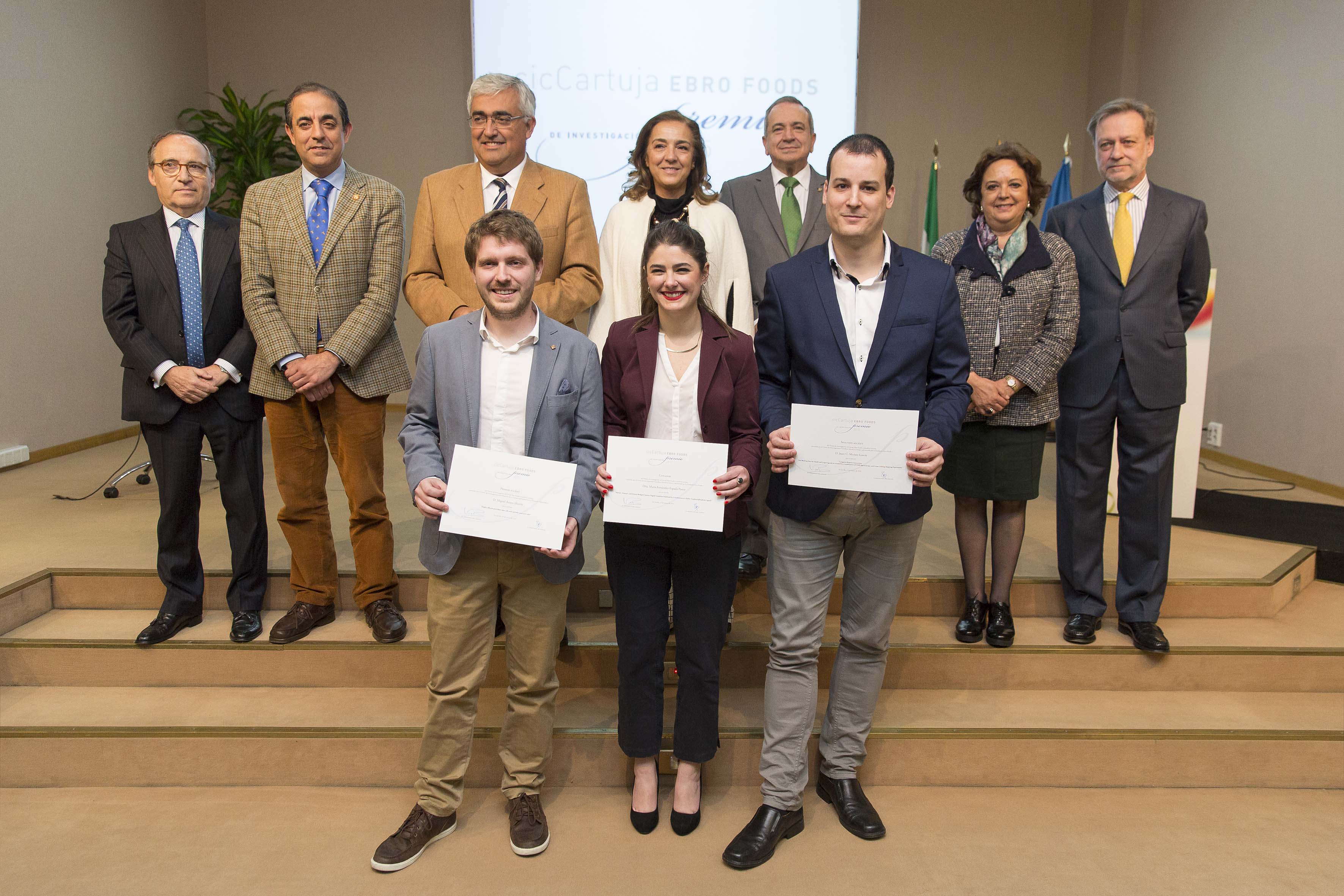Seville, March 4, 2016. The Sevillian María Fernández-Espada received today the “cicCartuja – Ebro Foods” Award in its sixth edition for a study that addresses the catalytic possibilities of gold. This award recognizes the work carried out by young researchers under 31 years of age, who have previously published scientific articles in journals of great international prestige, in areas such as chemistry, biochemistry or materials science.
The “cicCartuja – Ebro Foods” Award ceremony, held at the Isla de la Cartuja Scientific Research Center (cicCartuja), was attended by numerous members of the scientific community, as well as representatives from the political, business and university spheres. Among them, the Secretary of State for Research, Development and Innovation, Carmen Vela; the Minister of Economy and Knowledge, Antonio Ramírez de Arellano; the President of the CSIC, Emilio Lora-Tamayo; and the Rector of the University of Seville, Miguel Ángel Castro.
For his part, as director of cicCartuja, Miguel Ángel de la Rosa has highlighted the “dedication, perseverance and sacrifice” of the young winners, whose studies are “the result of the creative capacity, originality and knowledge of their directors and members of the research teams” who work daily at cicCartuja.
The catalytic potential of gold. The first of the distinguished articles, published by María Fernández-Espada in the journal Angewandte Chemie International Edition, focuses on the synthesis and characterization of hitherto unpublished gold complexes, which had been proposed in catalytic cycles at a theoretical level, but not in practice. Through experimental data, the 29-year-old IIQ researcher has provided a greater number of details on the electronic properties and chemical reactivity of these gold compounds; which represents an important advance for the incorporation of gold catalysts in future industrial processes. Associated with the Organometallic Chemistry and Homogeneous Catalysis research group, led by Professor Ernesto Carmona, María Fernández-Espada has analysed the bond in complexes containing various hydrocarbon bridges between two gold atoms. Her work places special emphasis on the function of methyl as a stabilising bridge between the two golds and on the phenomenon known as “aurophilia”, which is the chemical bond that occurs directly between the two golds. All of this helps to understand the transformations of gold, its optimisation and its potential as a new catalyst, that is, as a compound that accelerates chemical reactions and which, due to its versatility, could have multiple applications.
Coloured solar cells. The second award-winning work is signed by the Madrid researcher Miguel Anaya, belonging to the ICMS Multifunctional Optical Materials Group, led by Professor Hernán Míguez. His article, which appeared in the journal Nano Letters, has been awarded the first prize in the “cicCartuja – Ebro Foods” Prize for exploring the possibilities of perovskite as a compound applied in solar cells. At 27 years of age, Miguel Anaya, in collaboration with researchers from the ICMS and the University of Oxford, has designed perovskite solar cells with bright colours, ranging from blue to red; much more attractive than those previously manufactured in dark tones and, therefore, more appropriate to be integrated into building facades, bus shelters or awnings. With this article, which has generated a patent and has garnered an outstanding international impact in publications such as Science, Miguel Anaya has further expanded the alternatives offered by perovskite solar cells; a material that has revolutionised the field of photovoltaic technology since 2012, thanks to its unique optical and electrical properties, which allow for very low production costs. So much so that scientific efforts in recent years have made it possible to achieve efficiency values of 21% in this new type of device, close to those of well-established technologies on the market such as silicon solar cells.
Natural barriers against HIV. Finally, the second prize in the “cicCartuja – Ebro Foods” Award went to Juan Carlos Muñoz, a researcher at the IIQ, who is currently at the University of Oxford completing his postdoctoral stage. This 31-year-old scientist from Almería has shown that the protein langerin, which acts as a natural barrier during the early stages of HIV viral infection, interacts with the drug heparin. The latter is a complex molecule, with a variety of compositions, which is found surrounding our cells. For its part, langerin is produced by a type of immune system cells called Langerhans cells, present in the skin and genital mucosa, hence they constitute the first obstacle that HIV encounters in its infectious process.
With his article, published in the prestigious Journal of the American Chemical Society, Juan Carlos Muñoz, together with researchers from the IIQ Glycosystems Laboratory ‒Javier Rojo, Jesús Angulo and Pedro Nieto‒, raise the possibility of designing and developing drugs with greater efficacy against HIV, either by inhibiting cellular receptors that promote infection or by inducing an increase in the natural anti-HIV activity of the langerin receptor.
Amount of the award. Since 2010, the Isla de la Cartuja Scientific Research Centre ‒a joint centre of the Spanish National Research Council (CSIC), the Regional Government of Andalusia and the University of Seville‒ and Ebro Foods have awarded these prizes to promote the career of young researchers working at cicCartuja. In this sixth edition, the prize money for the “cicCartuja – Ebro Foods” Award reaches 20,000 euros, of which 10,000 euros are for the winner, 5,000 euros for the first runner-up and another 5,000 for the second runner-up. These amounts have been donated by the company Ebro Foods, which ‒through its president, Antonio Hernández Callejas‒, has supported the scientific excellence of the young researchers of cicCartuja and the transfer of knowledge from the laboratory to society.




